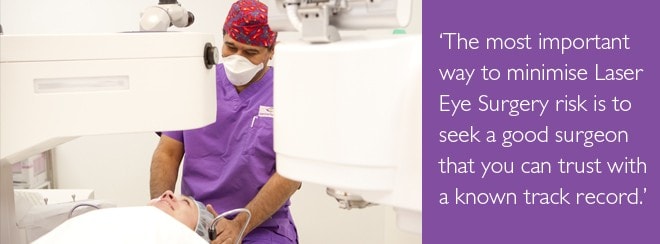What Are the Side Effects of LASIK?

One of the most common side effects after LASIK surgery is a sandy feeling in the eyes. Some patients also complain of tearing and mild pain. Patients may also be light sensitive for a couple of days. In addition, some patients may experience dryness and halos at night. However, these side effects are usually temporary and go away on their own.
LASIK surgery
There are a variety of side effects after LASIK surgery. Most of these will go away within a few weeks. Others will be more noticeable. Patients may experience tearing and a sandy feeling in their eyes for a few days. Some patients also complain of experiencing halos, particularly at night. Patients may also experience slight fluctuations in their vision for a few months.
LASIK complications
Some LASIK patients experience striae after surgery. These are typically benign, but may reduce the patient's visual acuity. To resolve the issue, the surgeon may irrigate the flap and then lay it back into place.
LASIK side effects
Although most patients experience a significant improvement in their vision following LASIK surgery, there are some common side effects that patients should expect. These side effects may include blurred vision, itching or burning in the eyes, or the sensation of a foreign object in the eye.
Halos
One of the most common side effects of LASIK is the appearance of halos around light sources. This phenomenon is caused by the fluid inside the recently treated cornea, which scatters light. This is normal, and will disappear once the fluid clears. In the meantime, a patient may experience halos, particularly in bright light. To minimize the appearance of halos, patients may want to avoid bright lights and use eye drops.
Starbursts
Patients may experience starbursts as a side effect from LASIK eye surgery, but this side effect usually goes away within a few days or weeks. Starbursts are caused by an irregular shape of the cornea and can significantly impact one's vision. Fortunately, most patients recover normal vision within a few months, although some may experience problems with their vision for life. In extreme cases, further treatment may be needed. For instance, if the starbursts are caused by refractive error, a patient may require prescription glasses or contact lenses.
Dry eye syndrome
Dry eye syndrome is a common complication of LASIK eye surgery. The process disrupts the corneal nerves, known as stromal and dense sub-basal nerve plexus. Another side effect of the procedure is the loss of corneal goblet cells. These cells never fully heal, and this leads to post-LASIK dry eye syndrome.
Temporary vision loss
Although LASIK has been shown to dramatically improve vision, the surgery is not permanent and results can change over time. Approximately 35 percent of LASIK patients need a follow-up procedure after 10 years, and 10 percent experience age-related vision changes after 12 years. The amount of tissue that is removed during the first surgery and what remains afterward will determine how many times a patient will need to have LASIK performed.
Suicide linked to LASIK
According to news reports, eleven people have committed suicide after undergoing LASIK eye surgery. Although the procedure itself is not thought to cause depression or suicidal thoughts, there have been numerous reports of people who suffered from intense pain and post-traumatic stress after the procedure. These complaints led the FDA to hold a special public hearing in 2008 about the dangers of Lasik surgery. During the hearing, leading surgeons testified against the procedure.
ARTICLE
